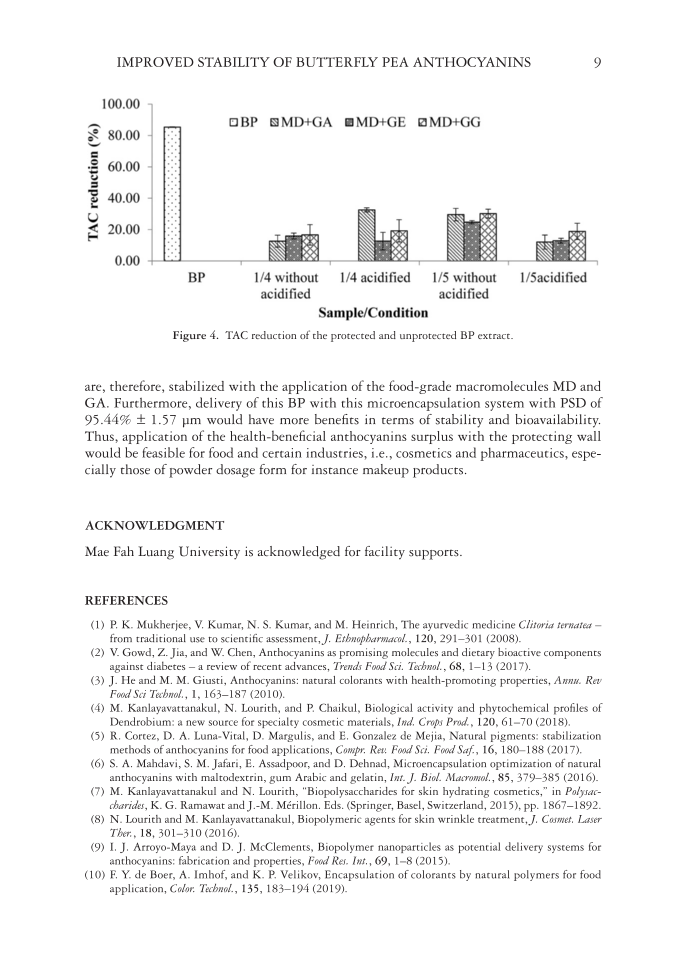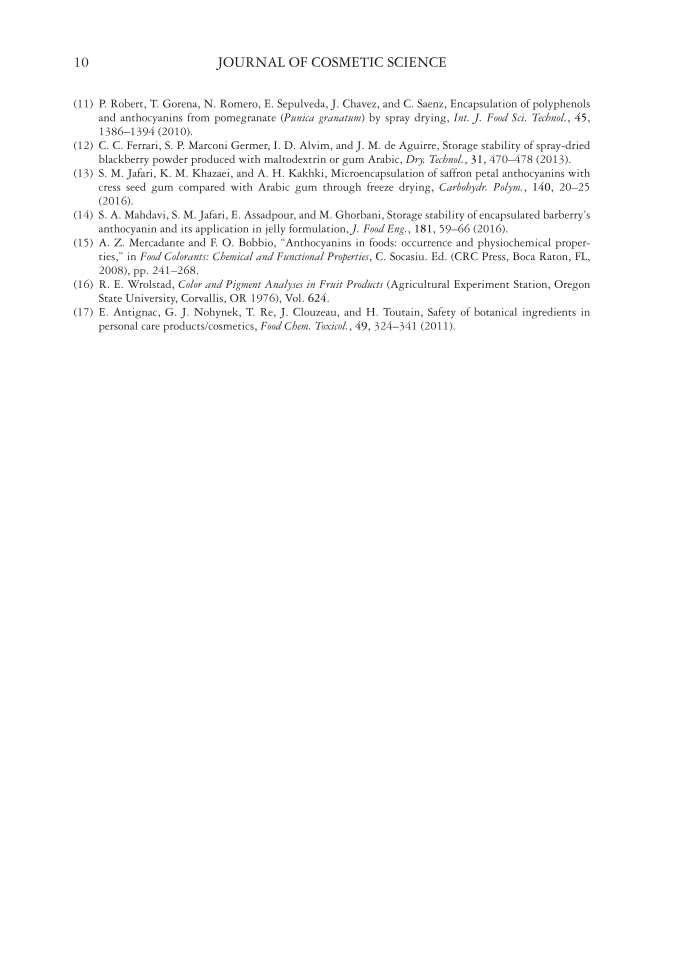IMPROVED STABILITY OF BUTTERFLY PEA ANTHOCYANINS 9 are, therefore, stabilized with the application of the food-grade macromolecules MD and GA. Furthermore, delivery of this BP with this microencapsulation system with PSD of 95.44% ± 1.57 μm would have more benefi ts in terms of stability and bioavailability. Thus, application of the health-benefi cial anthocyanins surplus with the protecting wall would be feasible for food and certain industries, i.e., cosmetics and pharmaceutics, espe- cially those of powder dosage form for instance makeup products. ACKNOWLEDGMENT Mae Fah Luang Un iversity is ack nowledged for facility supports. REFERENCES (1) P. K. Mukherjee , V. Kumar, N. S. Kumar, and M. Heinrich, The ayurvedic medicine Clitoria ternatea – from traditional use to scientifi c assessment, J. Ethnopharmacol., 120, 291–301 (2008). (2) V. Gowd, Z. Jia, and W. Ch e n, Anthocyanins as promising molecules and dietary bioactive components against diabetes – a review of recent advances, Trends Food Sci. Technol., 68, 1–13 (2017). (3) J. He and M. M. Giusti, An t hocyanins: natural colorants with health-promoting properties, Annu. Rev Food Sci Technol., 1, 163–187 (2010). (4) M. Kanlayavattanakul, N. Lo urith, and P. Chaikul, Biological activity and phytochemical profi les of Dendrobium: a new source for specialty cosmetic materials, Ind. Crops Prod., 120, 61–70 (2018). (5) R. Cortez, D. A. Luna-Vita l , D. Margulis, and E. Gonzalez de Mejia, Natural pigments: stabilization methods of anthocyanins for food applications, Compr. Rev. Food Sci. Food Saf., 16, 180–188 (2017). (6) S. A. Mahdavi, S. M. Jafar i , E. Assadpoor, and D. Dehnad, Microencapsulation optimization of natural anthocyanins with maltodextrin, gum Arabic and gelatin, Int. J. Biol. Macromol., 85, 379–385 (2016). (7) M. Kanlayavattanakul and N . Lourith, “Biopolysaccharides for skin hydrating cosmetics,” in Polysac- charides, K. G. Ramawat and J.-M. Mérillon. Eds. (Springer, Basel, Switzerland, 2015), pp. 1867–1892. (8) N. Lourith and M. Kanlayava t tanakul, Biopolymeric agents for skin wrinkle treatment, J. Cosmet. Laser Ther., 18, 301–310 (2016). (9) I. J. Arroyo-Maya and D. J. McClements, Biopolymer nanoparticles as potential delivery systems for anthocyanins: fabrication and properties, Food Res. Int., 69, 1–8 (2015). (10) F. Y. de Boer, A. Imhof, a n d K. P. Velikov, Encapsulation of colorants by natural polymers for food application, Color. Technol., 135, 183–194 (2019). Figure 4. TAC reduction of the prot e cted and unprotected BP extract.
JOURNAL OF COSMETIC SCIENCE 10 (11) P. Robert, T. Gorena, N. R o mero, E. Sepulveda, J. Chavez, and C. Saenz, Encapsulation of polyphenols and anthocyanins from pomegranate (Punica granatum) by spray drying, Int. J. Food Sci. Technol., 45, 1386–1394 (2010). (12) C. C. Ferrari, S. P. Marco n i Germer, I. D. Alvim, and J. M. de Aguirre, Storage stability of spray-dried blackberry powder produced with maltodextrin or gum Arabic, Dry. Technol., 31, 470–478 (2013). (13) S. M. Jafari, K. M. Khazaei , and A. H. Kakhki, Microencapsulation of saffron petal anthocyanins with cress seed gum compared with Arabic gum through freeze drying, Carbohydr. Polym., 140, 20–25 (2016). (14) S. A. Mahdavi, S. M. Jafar i , E. Assadpour, and M. Ghorbani, Storage stability of encapsulated barberry’s anthocyanin and its application in jelly formulation, J. Food Eng., 181, 59–66 (2016). (15) A. Z. Mercadante and F. O. Bobbio, “Anthocyanins in foods: occurrence and physiochemical proper- ties,” in Food Colorants: Chemical and Functional Properties, C. Socasiu. Ed. (CRC Press, Boca Raton, FL, 2008), pp. 241–268. (16) R. E. Wrolstad, Color and P igment Analyses in Fruit Products (Agricultural Experiment Station, Oregon State University, Corvallis, OR 1976), Vol. 624. (17) E. Antignac, G. J. Nohynek, T. Re, J. Clouzeau, and H. Toutain, Safety of botanical ingredients in personal care products/cosmetics, Food Chem. Toxicol., 49, 324–341 (2011).
Purchased for the exclusive use of nofirst nolast (unknown) From: SCC Media Library & Resource Center (library.scconline.org)


























































